BM563 Operations Management: Sainsbury's Supply Chain Improvement
VerifiedAdded on 2023/06/10
|12
|2914
|470
Report
AI Summary
This report provides an analysis of Sainsbury's operations and service management, focusing on supply chain management. It identifies supply chain operation management practices within Sainsbury's, critically analyzes their impact on organizational efficiency, and evaluates how technology, such as demand forecasting, artificial intelligence, and warehouse robotics, could be embedded to enhance the process. The report also discusses supporting functions like purchasing and how they contribute to organizational success. The analysis covers Sainsbury's use of the Kraljic procurement matrix, logistics contracts, and aims to reduce costs through new supply chain and logistics operations. The report concludes that effective supply chain management is crucial for Sainsbury's to maintain a competitive edge in the retail market, enhance customer satisfaction, and adhere to legal and ethical policies.
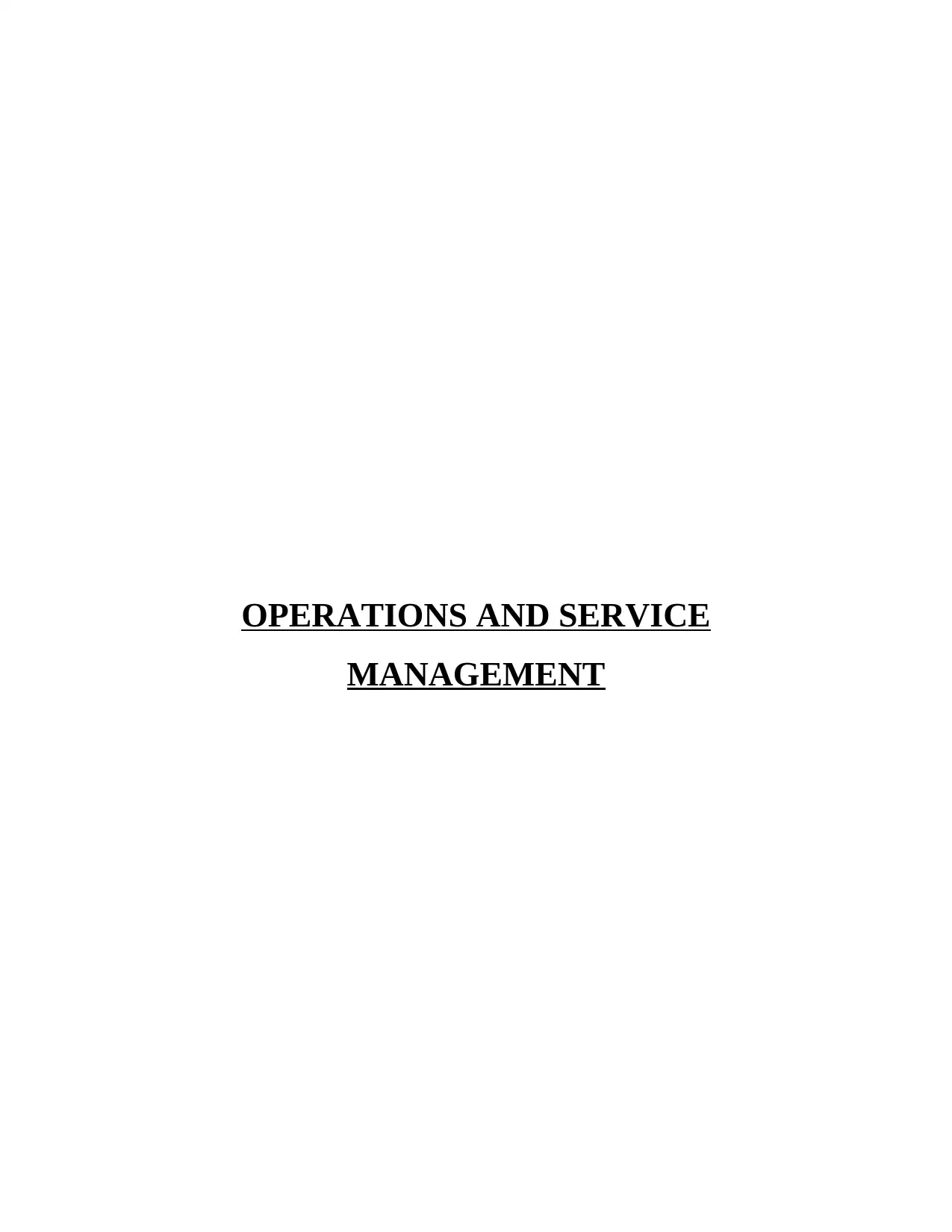
OPERATIONS AND SERVICE
MANAGEMENT
MANAGEMENT
Paraphrase This Document
Need a fresh take? Get an instant paraphrase of this document with our AI Paraphraser
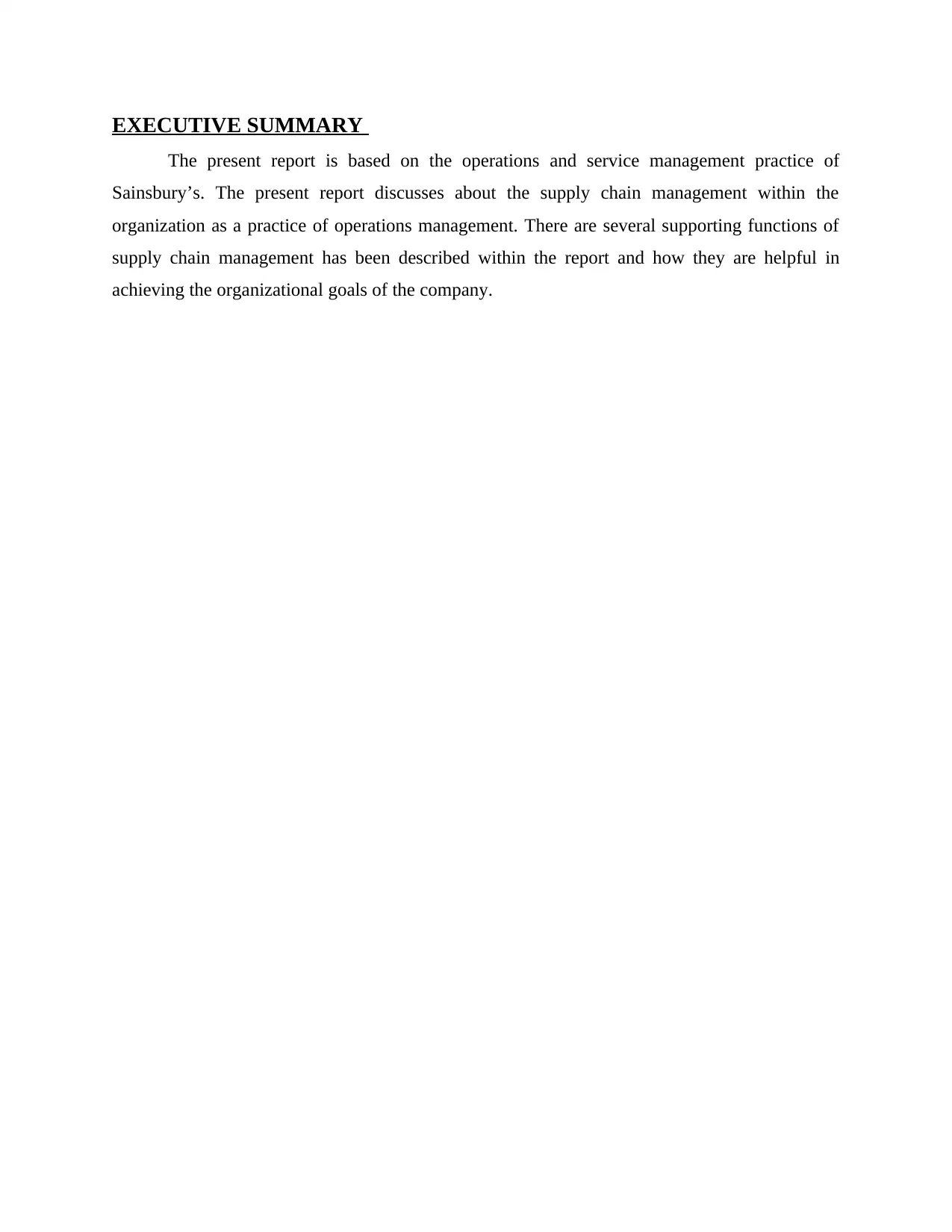
EXECUTIVE SUMMARY
The present report is based on the operations and service management practice of
Sainsbury’s. The present report discusses about the supply chain management within the
organization as a practice of operations management. There are several supporting functions of
supply chain management has been described within the report and how they are helpful in
achieving the organizational goals of the company.
The present report is based on the operations and service management practice of
Sainsbury’s. The present report discusses about the supply chain management within the
organization as a practice of operations management. There are several supporting functions of
supply chain management has been described within the report and how they are helpful in
achieving the organizational goals of the company.
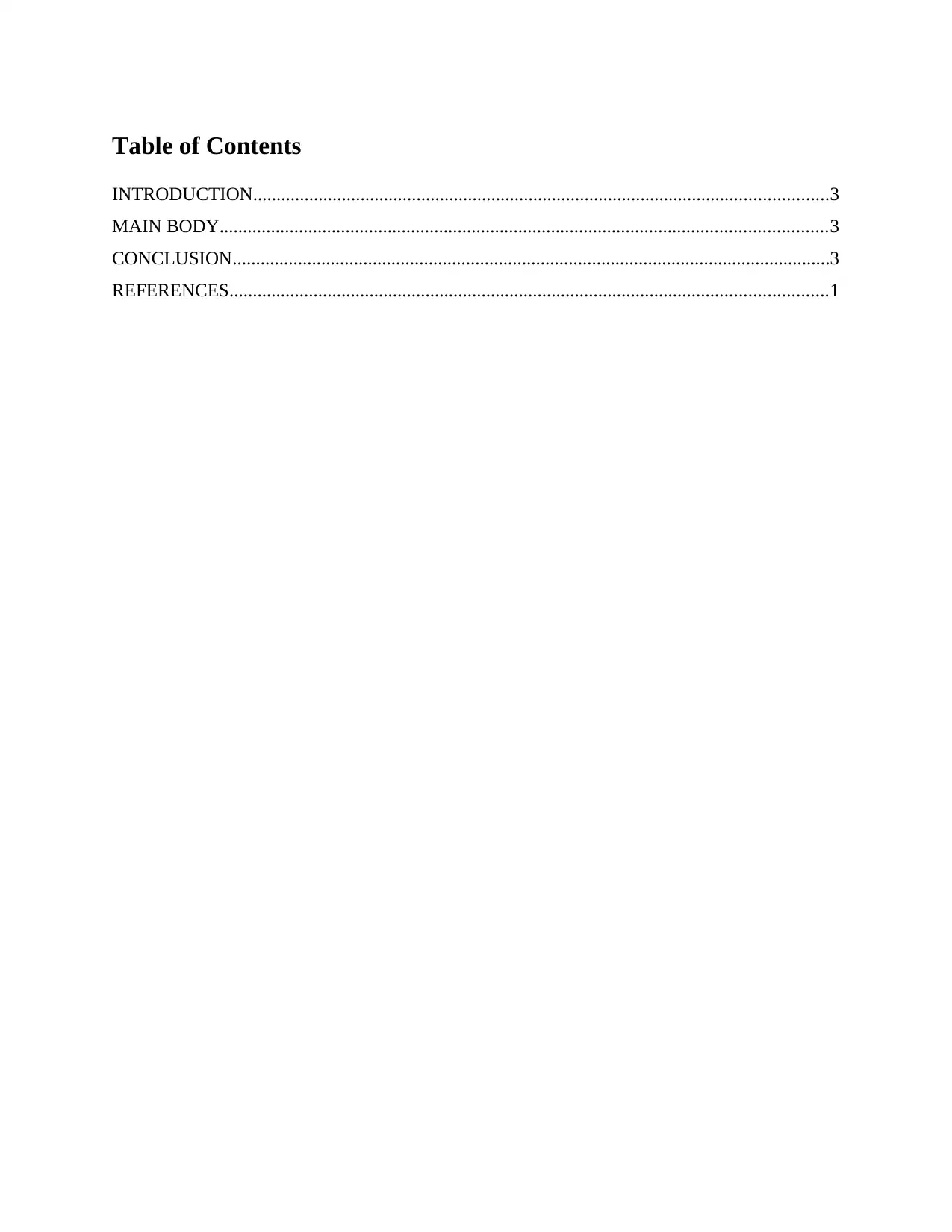
Table of Contents
INTRODUCTION...........................................................................................................................3
MAIN BODY..................................................................................................................................3
CONCLUSION................................................................................................................................3
REFERENCES................................................................................................................................1
INTRODUCTION...........................................................................................................................3
MAIN BODY..................................................................................................................................3
CONCLUSION................................................................................................................................3
REFERENCES................................................................................................................................1
⊘ This is a preview!⊘
Do you want full access?
Subscribe today to unlock all pages.

Trusted by 1+ million students worldwide
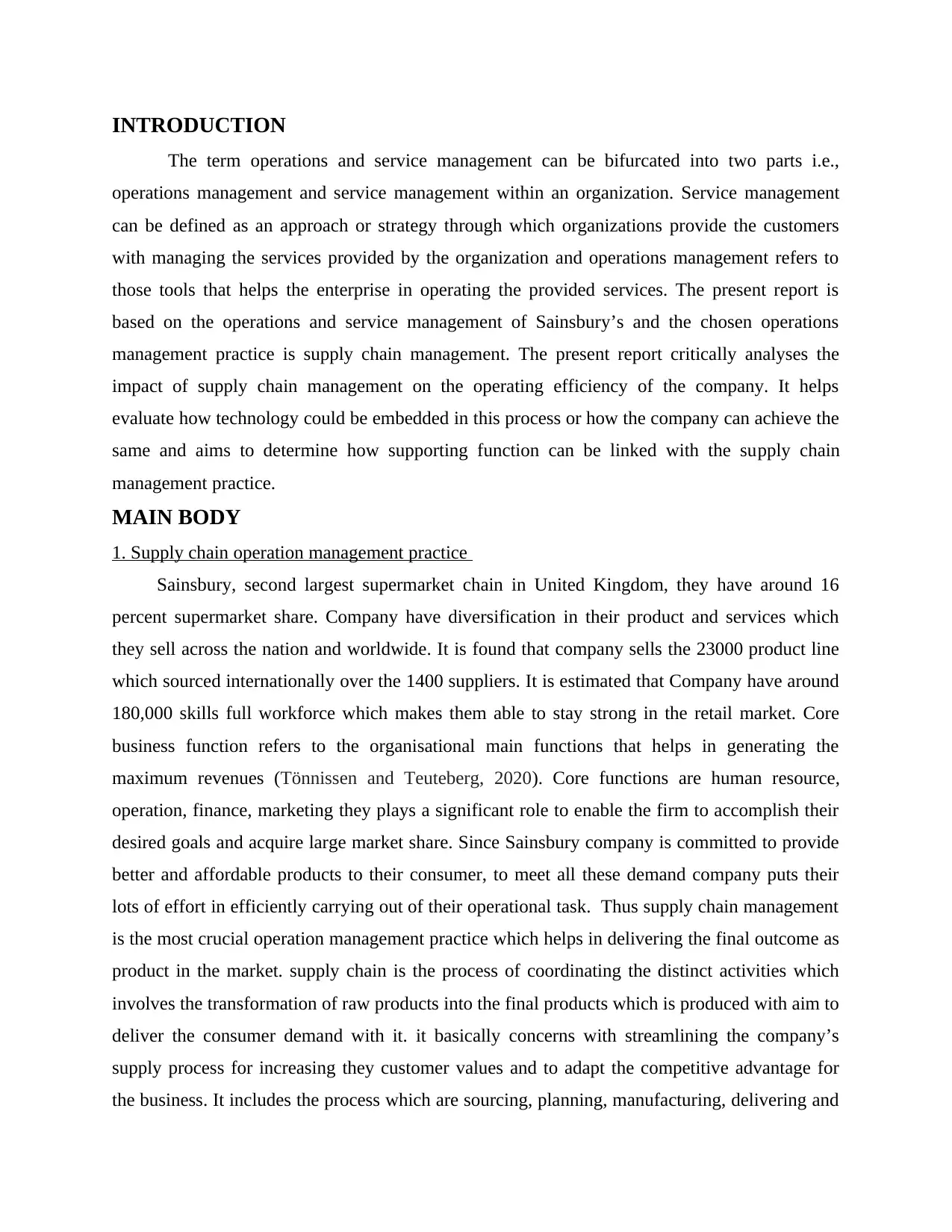
INTRODUCTION
The term operations and service management can be bifurcated into two parts i.e.,
operations management and service management within an organization. Service management
can be defined as an approach or strategy through which organizations provide the customers
with managing the services provided by the organization and operations management refers to
those tools that helps the enterprise in operating the provided services. The present report is
based on the operations and service management of Sainsbury’s and the chosen operations
management practice is supply chain management. The present report critically analyses the
impact of supply chain management on the operating efficiency of the company. It helps
evaluate how technology could be embedded in this process or how the company can achieve the
same and aims to determine how supporting function can be linked with the supply chain
management practice.
MAIN BODY
1. Supply chain operation management practice
Sainsbury, second largest supermarket chain in United Kingdom, they have around 16
percent supermarket share. Company have diversification in their product and services which
they sell across the nation and worldwide. It is found that company sells the 23000 product line
which sourced internationally over the 1400 suppliers. It is estimated that Company have around
180,000 skills full workforce which makes them able to stay strong in the retail market. Core
business function refers to the organisational main functions that helps in generating the
maximum revenues (Tönnissen and Teuteberg, 2020). Core functions are human resource,
operation, finance, marketing they plays a significant role to enable the firm to accomplish their
desired goals and acquire large market share. Since Sainsbury company is committed to provide
better and affordable products to their consumer, to meet all these demand company puts their
lots of effort in efficiently carrying out of their operational task. Thus supply chain management
is the most crucial operation management practice which helps in delivering the final outcome as
product in the market. supply chain is the process of coordinating the distinct activities which
involves the transformation of raw products into the final products which is produced with aim to
deliver the consumer demand with it. it basically concerns with streamlining the company’s
supply process for increasing they customer values and to adapt the competitive advantage for
the business. It includes the process which are sourcing, planning, manufacturing, delivering and
The term operations and service management can be bifurcated into two parts i.e.,
operations management and service management within an organization. Service management
can be defined as an approach or strategy through which organizations provide the customers
with managing the services provided by the organization and operations management refers to
those tools that helps the enterprise in operating the provided services. The present report is
based on the operations and service management of Sainsbury’s and the chosen operations
management practice is supply chain management. The present report critically analyses the
impact of supply chain management on the operating efficiency of the company. It helps
evaluate how technology could be embedded in this process or how the company can achieve the
same and aims to determine how supporting function can be linked with the supply chain
management practice.
MAIN BODY
1. Supply chain operation management practice
Sainsbury, second largest supermarket chain in United Kingdom, they have around 16
percent supermarket share. Company have diversification in their product and services which
they sell across the nation and worldwide. It is found that company sells the 23000 product line
which sourced internationally over the 1400 suppliers. It is estimated that Company have around
180,000 skills full workforce which makes them able to stay strong in the retail market. Core
business function refers to the organisational main functions that helps in generating the
maximum revenues (Tönnissen and Teuteberg, 2020). Core functions are human resource,
operation, finance, marketing they plays a significant role to enable the firm to accomplish their
desired goals and acquire large market share. Since Sainsbury company is committed to provide
better and affordable products to their consumer, to meet all these demand company puts their
lots of effort in efficiently carrying out of their operational task. Thus supply chain management
is the most crucial operation management practice which helps in delivering the final outcome as
product in the market. supply chain is the process of coordinating the distinct activities which
involves the transformation of raw products into the final products which is produced with aim to
deliver the consumer demand with it. it basically concerns with streamlining the company’s
supply process for increasing they customer values and to adapt the competitive advantage for
the business. It includes the process which are sourcing, planning, manufacturing, delivering and
Paraphrase This Document
Need a fresh take? Get an instant paraphrase of this document with our AI Paraphraser
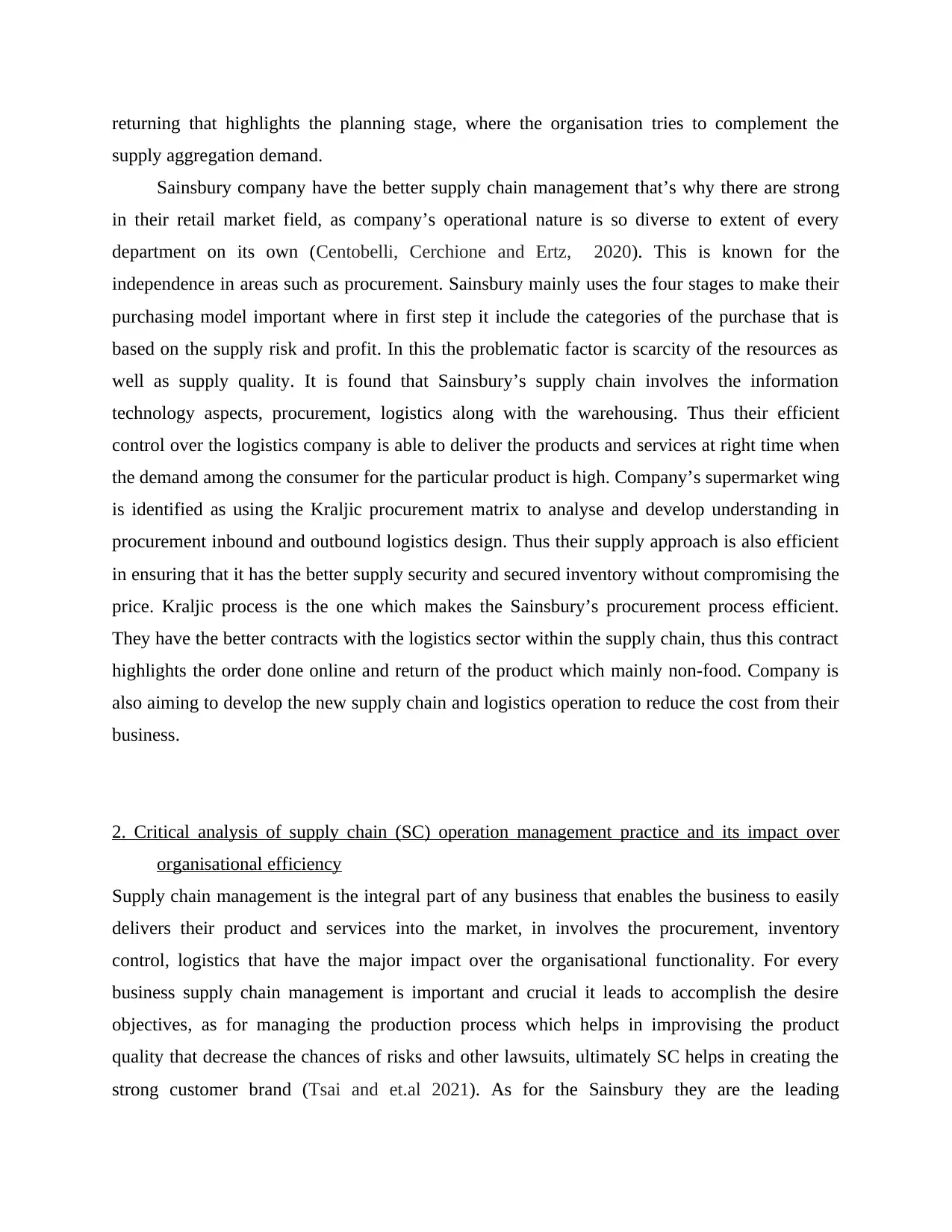
returning that highlights the planning stage, where the organisation tries to complement the
supply aggregation demand.
Sainsbury company have the better supply chain management that’s why there are strong
in their retail market field, as company’s operational nature is so diverse to extent of every
department on its own (Centobelli, Cerchione and Ertz, 2020). This is known for the
independence in areas such as procurement. Sainsbury mainly uses the four stages to make their
purchasing model important where in first step it include the categories of the purchase that is
based on the supply risk and profit. In this the problematic factor is scarcity of the resources as
well as supply quality. It is found that Sainsbury’s supply chain involves the information
technology aspects, procurement, logistics along with the warehousing. Thus their efficient
control over the logistics company is able to deliver the products and services at right time when
the demand among the consumer for the particular product is high. Company’s supermarket wing
is identified as using the Kraljic procurement matrix to analyse and develop understanding in
procurement inbound and outbound logistics design. Thus their supply approach is also efficient
in ensuring that it has the better supply security and secured inventory without compromising the
price. Kraljic process is the one which makes the Sainsbury’s procurement process efficient.
They have the better contracts with the logistics sector within the supply chain, thus this contract
highlights the order done online and return of the product which mainly non-food. Company is
also aiming to develop the new supply chain and logistics operation to reduce the cost from their
business.
2. Critical analysis of supply chain (SC) operation management practice and its impact over
organisational efficiency
Supply chain management is the integral part of any business that enables the business to easily
delivers their product and services into the market, in involves the procurement, inventory
control, logistics that have the major impact over the organisational functionality. For every
business supply chain management is important and crucial it leads to accomplish the desire
objectives, as for managing the production process which helps in improvising the product
quality that decrease the chances of risks and other lawsuits, ultimately SC helps in creating the
strong customer brand (Tsai and et.al 2021). As for the Sainsbury they are the leading
supply aggregation demand.
Sainsbury company have the better supply chain management that’s why there are strong
in their retail market field, as company’s operational nature is so diverse to extent of every
department on its own (Centobelli, Cerchione and Ertz, 2020). This is known for the
independence in areas such as procurement. Sainsbury mainly uses the four stages to make their
purchasing model important where in first step it include the categories of the purchase that is
based on the supply risk and profit. In this the problematic factor is scarcity of the resources as
well as supply quality. It is found that Sainsbury’s supply chain involves the information
technology aspects, procurement, logistics along with the warehousing. Thus their efficient
control over the logistics company is able to deliver the products and services at right time when
the demand among the consumer for the particular product is high. Company’s supermarket wing
is identified as using the Kraljic procurement matrix to analyse and develop understanding in
procurement inbound and outbound logistics design. Thus their supply approach is also efficient
in ensuring that it has the better supply security and secured inventory without compromising the
price. Kraljic process is the one which makes the Sainsbury’s procurement process efficient.
They have the better contracts with the logistics sector within the supply chain, thus this contract
highlights the order done online and return of the product which mainly non-food. Company is
also aiming to develop the new supply chain and logistics operation to reduce the cost from their
business.
2. Critical analysis of supply chain (SC) operation management practice and its impact over
organisational efficiency
Supply chain management is the integral part of any business that enables the business to easily
delivers their product and services into the market, in involves the procurement, inventory
control, logistics that have the major impact over the organisational functionality. For every
business supply chain management is important and crucial it leads to accomplish the desire
objectives, as for managing the production process which helps in improvising the product
quality that decrease the chances of risks and other lawsuits, ultimately SC helps in creating the
strong customer brand (Tsai and et.al 2021). As for the Sainsbury they are the leading
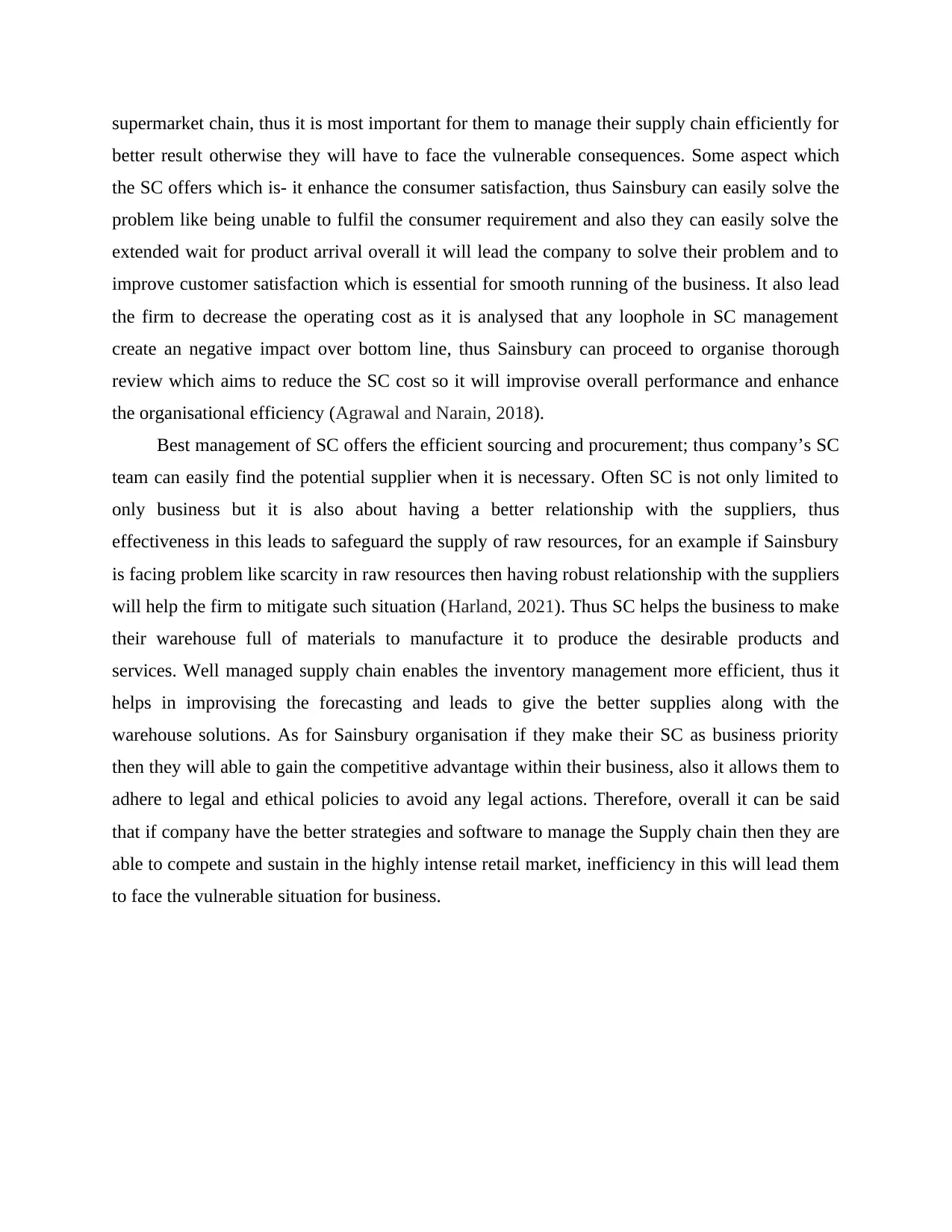
supermarket chain, thus it is most important for them to manage their supply chain efficiently for
better result otherwise they will have to face the vulnerable consequences. Some aspect which
the SC offers which is- it enhance the consumer satisfaction, thus Sainsbury can easily solve the
problem like being unable to fulfil the consumer requirement and also they can easily solve the
extended wait for product arrival overall it will lead the company to solve their problem and to
improve customer satisfaction which is essential for smooth running of the business. It also lead
the firm to decrease the operating cost as it is analysed that any loophole in SC management
create an negative impact over bottom line, thus Sainsbury can proceed to organise thorough
review which aims to reduce the SC cost so it will improvise overall performance and enhance
the organisational efficiency (Agrawal and Narain, 2018).
Best management of SC offers the efficient sourcing and procurement; thus company’s SC
team can easily find the potential supplier when it is necessary. Often SC is not only limited to
only business but it is also about having a better relationship with the suppliers, thus
effectiveness in this leads to safeguard the supply of raw resources, for an example if Sainsbury
is facing problem like scarcity in raw resources then having robust relationship with the suppliers
will help the firm to mitigate such situation (Harland, 2021). Thus SC helps the business to make
their warehouse full of materials to manufacture it to produce the desirable products and
services. Well managed supply chain enables the inventory management more efficient, thus it
helps in improvising the forecasting and leads to give the better supplies along with the
warehouse solutions. As for Sainsbury organisation if they make their SC as business priority
then they will able to gain the competitive advantage within their business, also it allows them to
adhere to legal and ethical policies to avoid any legal actions. Therefore, overall it can be said
that if company have the better strategies and software to manage the Supply chain then they are
able to compete and sustain in the highly intense retail market, inefficiency in this will lead them
to face the vulnerable situation for business.
better result otherwise they will have to face the vulnerable consequences. Some aspect which
the SC offers which is- it enhance the consumer satisfaction, thus Sainsbury can easily solve the
problem like being unable to fulfil the consumer requirement and also they can easily solve the
extended wait for product arrival overall it will lead the company to solve their problem and to
improve customer satisfaction which is essential for smooth running of the business. It also lead
the firm to decrease the operating cost as it is analysed that any loophole in SC management
create an negative impact over bottom line, thus Sainsbury can proceed to organise thorough
review which aims to reduce the SC cost so it will improvise overall performance and enhance
the organisational efficiency (Agrawal and Narain, 2018).
Best management of SC offers the efficient sourcing and procurement; thus company’s SC
team can easily find the potential supplier when it is necessary. Often SC is not only limited to
only business but it is also about having a better relationship with the suppliers, thus
effectiveness in this leads to safeguard the supply of raw resources, for an example if Sainsbury
is facing problem like scarcity in raw resources then having robust relationship with the suppliers
will help the firm to mitigate such situation (Harland, 2021). Thus SC helps the business to make
their warehouse full of materials to manufacture it to produce the desirable products and
services. Well managed supply chain enables the inventory management more efficient, thus it
helps in improvising the forecasting and leads to give the better supplies along with the
warehouse solutions. As for Sainsbury organisation if they make their SC as business priority
then they will able to gain the competitive advantage within their business, also it allows them to
adhere to legal and ethical policies to avoid any legal actions. Therefore, overall it can be said
that if company have the better strategies and software to manage the Supply chain then they are
able to compete and sustain in the highly intense retail market, inefficiency in this will lead them
to face the vulnerable situation for business.
⊘ This is a preview!⊘
Do you want full access?
Subscribe today to unlock all pages.

Trusted by 1+ million students worldwide
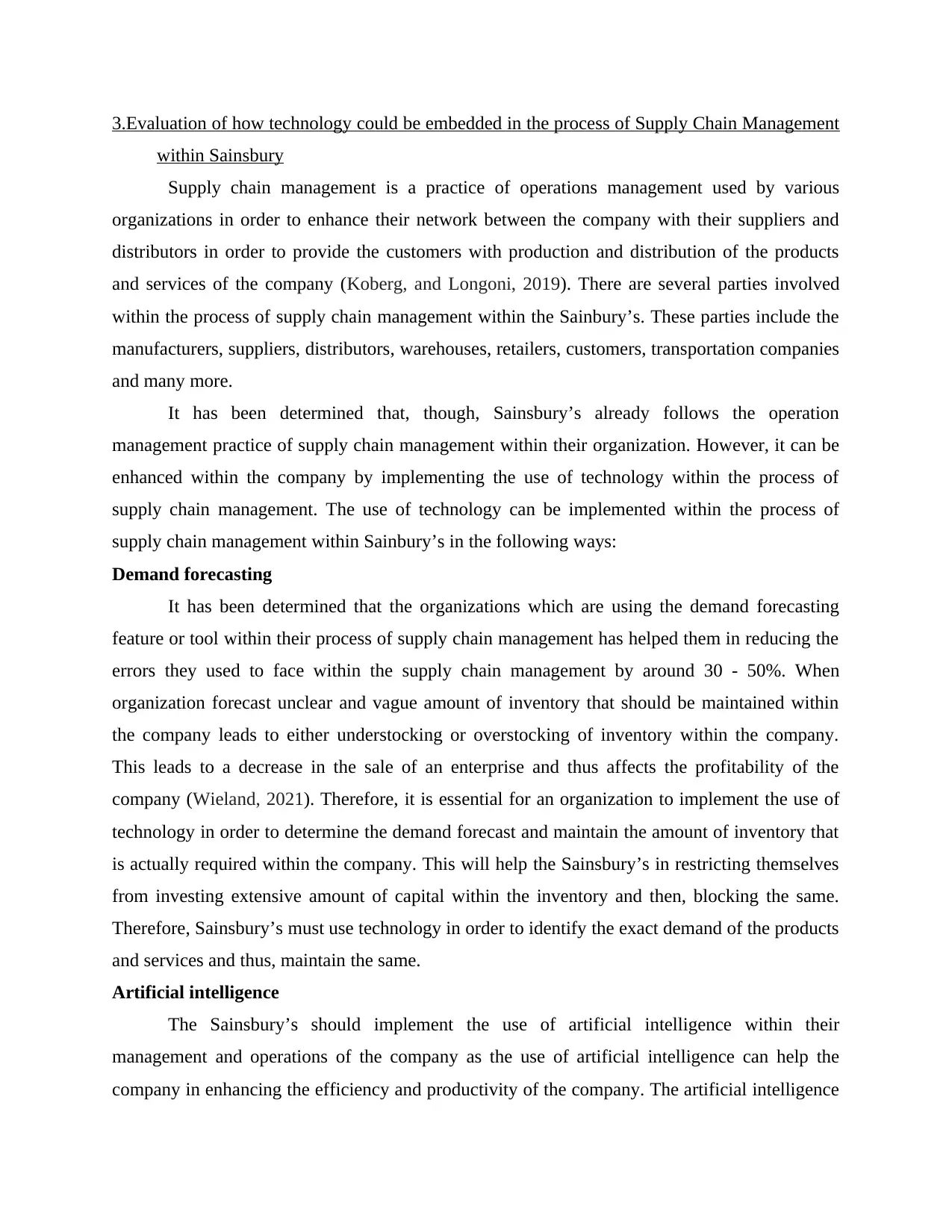
3.Evaluation of how technology could be embedded in the process of Supply Chain Management
within Sainsbury
Supply chain management is a practice of operations management used by various
organizations in order to enhance their network between the company with their suppliers and
distributors in order to provide the customers with production and distribution of the products
and services of the company (Koberg, and Longoni, 2019). There are several parties involved
within the process of supply chain management within the Sainbury’s. These parties include the
manufacturers, suppliers, distributors, warehouses, retailers, customers, transportation companies
and many more.
It has been determined that, though, Sainsbury’s already follows the operation
management practice of supply chain management within their organization. However, it can be
enhanced within the company by implementing the use of technology within the process of
supply chain management. The use of technology can be implemented within the process of
supply chain management within Sainbury’s in the following ways:
Demand forecasting
It has been determined that the organizations which are using the demand forecasting
feature or tool within their process of supply chain management has helped them in reducing the
errors they used to face within the supply chain management by around 30 - 50%. When
organization forecast unclear and vague amount of inventory that should be maintained within
the company leads to either understocking or overstocking of inventory within the company.
This leads to a decrease in the sale of an enterprise and thus affects the profitability of the
company (Wieland, 2021). Therefore, it is essential for an organization to implement the use of
technology in order to determine the demand forecast and maintain the amount of inventory that
is actually required within the company. This will help the Sainsbury’s in restricting themselves
from investing extensive amount of capital within the inventory and then, blocking the same.
Therefore, Sainsbury’s must use technology in order to identify the exact demand of the products
and services and thus, maintain the same.
Artificial intelligence
The Sainsbury’s should implement the use of artificial intelligence within their
management and operations of the company as the use of artificial intelligence can help the
company in enhancing the efficiency and productivity of the company. The artificial intelligence
within Sainsbury
Supply chain management is a practice of operations management used by various
organizations in order to enhance their network between the company with their suppliers and
distributors in order to provide the customers with production and distribution of the products
and services of the company (Koberg, and Longoni, 2019). There are several parties involved
within the process of supply chain management within the Sainbury’s. These parties include the
manufacturers, suppliers, distributors, warehouses, retailers, customers, transportation companies
and many more.
It has been determined that, though, Sainsbury’s already follows the operation
management practice of supply chain management within their organization. However, it can be
enhanced within the company by implementing the use of technology within the process of
supply chain management. The use of technology can be implemented within the process of
supply chain management within Sainbury’s in the following ways:
Demand forecasting
It has been determined that the organizations which are using the demand forecasting
feature or tool within their process of supply chain management has helped them in reducing the
errors they used to face within the supply chain management by around 30 - 50%. When
organization forecast unclear and vague amount of inventory that should be maintained within
the company leads to either understocking or overstocking of inventory within the company.
This leads to a decrease in the sale of an enterprise and thus affects the profitability of the
company (Wieland, 2021). Therefore, it is essential for an organization to implement the use of
technology in order to determine the demand forecast and maintain the amount of inventory that
is actually required within the company. This will help the Sainsbury’s in restricting themselves
from investing extensive amount of capital within the inventory and then, blocking the same.
Therefore, Sainsbury’s must use technology in order to identify the exact demand of the products
and services and thus, maintain the same.
Artificial intelligence
The Sainsbury’s should implement the use of artificial intelligence within their
management and operations of the company as the use of artificial intelligence can help the
company in enhancing the efficiency and productivity of the company. The artificial intelligence
Paraphrase This Document
Need a fresh take? Get an instant paraphrase of this document with our AI Paraphraser
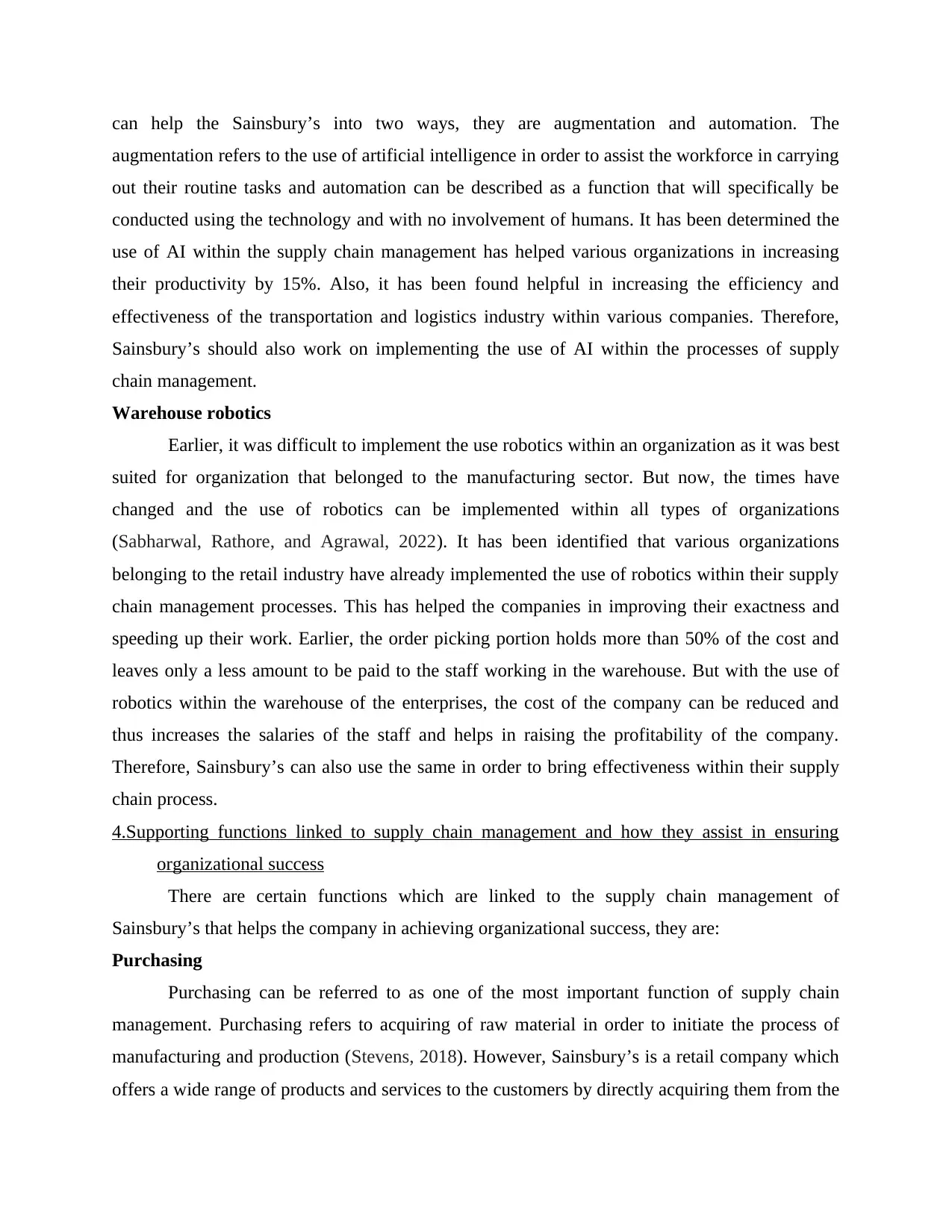
can help the Sainsbury’s into two ways, they are augmentation and automation. The
augmentation refers to the use of artificial intelligence in order to assist the workforce in carrying
out their routine tasks and automation can be described as a function that will specifically be
conducted using the technology and with no involvement of humans. It has been determined the
use of AI within the supply chain management has helped various organizations in increasing
their productivity by 15%. Also, it has been found helpful in increasing the efficiency and
effectiveness of the transportation and logistics industry within various companies. Therefore,
Sainsbury’s should also work on implementing the use of AI within the processes of supply
chain management.
Warehouse robotics
Earlier, it was difficult to implement the use robotics within an organization as it was best
suited for organization that belonged to the manufacturing sector. But now, the times have
changed and the use of robotics can be implemented within all types of organizations
(Sabharwal, Rathore, and Agrawal, 2022). It has been identified that various organizations
belonging to the retail industry have already implemented the use of robotics within their supply
chain management processes. This has helped the companies in improving their exactness and
speeding up their work. Earlier, the order picking portion holds more than 50% of the cost and
leaves only a less amount to be paid to the staff working in the warehouse. But with the use of
robotics within the warehouse of the enterprises, the cost of the company can be reduced and
thus increases the salaries of the staff and helps in raising the profitability of the company.
Therefore, Sainsbury’s can also use the same in order to bring effectiveness within their supply
chain process.
4.Supporting functions linked to supply chain management and how they assist in ensuring
organizational success
There are certain functions which are linked to the supply chain management of
Sainsbury’s that helps the company in achieving organizational success, they are:
Purchasing
Purchasing can be referred to as one of the most important function of supply chain
management. Purchasing refers to acquiring of raw material in order to initiate the process of
manufacturing and production (Stevens, 2018). However, Sainsbury’s is a retail company which
offers a wide range of products and services to the customers by directly acquiring them from the
augmentation refers to the use of artificial intelligence in order to assist the workforce in carrying
out their routine tasks and automation can be described as a function that will specifically be
conducted using the technology and with no involvement of humans. It has been determined the
use of AI within the supply chain management has helped various organizations in increasing
their productivity by 15%. Also, it has been found helpful in increasing the efficiency and
effectiveness of the transportation and logistics industry within various companies. Therefore,
Sainsbury’s should also work on implementing the use of AI within the processes of supply
chain management.
Warehouse robotics
Earlier, it was difficult to implement the use robotics within an organization as it was best
suited for organization that belonged to the manufacturing sector. But now, the times have
changed and the use of robotics can be implemented within all types of organizations
(Sabharwal, Rathore, and Agrawal, 2022). It has been identified that various organizations
belonging to the retail industry have already implemented the use of robotics within their supply
chain management processes. This has helped the companies in improving their exactness and
speeding up their work. Earlier, the order picking portion holds more than 50% of the cost and
leaves only a less amount to be paid to the staff working in the warehouse. But with the use of
robotics within the warehouse of the enterprises, the cost of the company can be reduced and
thus increases the salaries of the staff and helps in raising the profitability of the company.
Therefore, Sainsbury’s can also use the same in order to bring effectiveness within their supply
chain process.
4.Supporting functions linked to supply chain management and how they assist in ensuring
organizational success
There are certain functions which are linked to the supply chain management of
Sainsbury’s that helps the company in achieving organizational success, they are:
Purchasing
Purchasing can be referred to as one of the most important function of supply chain
management. Purchasing refers to acquiring of raw material in order to initiate the process of
manufacturing and production (Stevens, 2018). However, Sainsbury’s is a retail company which
offers a wide range of products and services to the customers by directly acquiring them from the
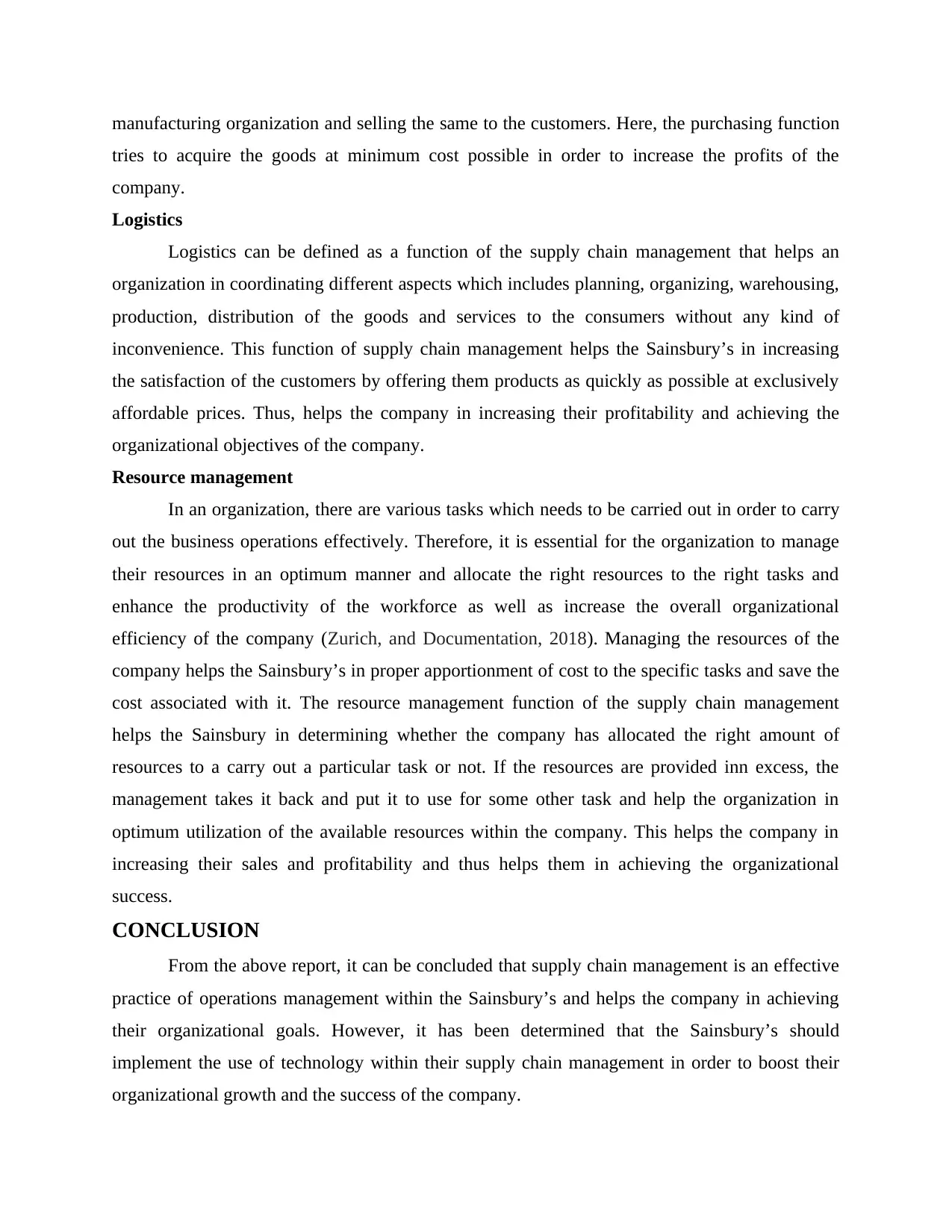
manufacturing organization and selling the same to the customers. Here, the purchasing function
tries to acquire the goods at minimum cost possible in order to increase the profits of the
company.
Logistics
Logistics can be defined as a function of the supply chain management that helps an
organization in coordinating different aspects which includes planning, organizing, warehousing,
production, distribution of the goods and services to the consumers without any kind of
inconvenience. This function of supply chain management helps the Sainsbury’s in increasing
the satisfaction of the customers by offering them products as quickly as possible at exclusively
affordable prices. Thus, helps the company in increasing their profitability and achieving the
organizational objectives of the company.
Resource management
In an organization, there are various tasks which needs to be carried out in order to carry
out the business operations effectively. Therefore, it is essential for the organization to manage
their resources in an optimum manner and allocate the right resources to the right tasks and
enhance the productivity of the workforce as well as increase the overall organizational
efficiency of the company (Zurich, and Documentation, 2018). Managing the resources of the
company helps the Sainsbury’s in proper apportionment of cost to the specific tasks and save the
cost associated with it. The resource management function of the supply chain management
helps the Sainsbury in determining whether the company has allocated the right amount of
resources to a carry out a particular task or not. If the resources are provided inn excess, the
management takes it back and put it to use for some other task and help the organization in
optimum utilization of the available resources within the company. This helps the company in
increasing their sales and profitability and thus helps them in achieving the organizational
success.
CONCLUSION
From the above report, it can be concluded that supply chain management is an effective
practice of operations management within the Sainsbury’s and helps the company in achieving
their organizational goals. However, it has been determined that the Sainsbury’s should
implement the use of technology within their supply chain management in order to boost their
organizational growth and the success of the company.
tries to acquire the goods at minimum cost possible in order to increase the profits of the
company.
Logistics
Logistics can be defined as a function of the supply chain management that helps an
organization in coordinating different aspects which includes planning, organizing, warehousing,
production, distribution of the goods and services to the consumers without any kind of
inconvenience. This function of supply chain management helps the Sainsbury’s in increasing
the satisfaction of the customers by offering them products as quickly as possible at exclusively
affordable prices. Thus, helps the company in increasing their profitability and achieving the
organizational objectives of the company.
Resource management
In an organization, there are various tasks which needs to be carried out in order to carry
out the business operations effectively. Therefore, it is essential for the organization to manage
their resources in an optimum manner and allocate the right resources to the right tasks and
enhance the productivity of the workforce as well as increase the overall organizational
efficiency of the company (Zurich, and Documentation, 2018). Managing the resources of the
company helps the Sainsbury’s in proper apportionment of cost to the specific tasks and save the
cost associated with it. The resource management function of the supply chain management
helps the Sainsbury in determining whether the company has allocated the right amount of
resources to a carry out a particular task or not. If the resources are provided inn excess, the
management takes it back and put it to use for some other task and help the organization in
optimum utilization of the available resources within the company. This helps the company in
increasing their sales and profitability and thus helps them in achieving the organizational
success.
CONCLUSION
From the above report, it can be concluded that supply chain management is an effective
practice of operations management within the Sainsbury’s and helps the company in achieving
their organizational goals. However, it has been determined that the Sainsbury’s should
implement the use of technology within their supply chain management in order to boost their
organizational growth and the success of the company.
⊘ This is a preview!⊘
Do you want full access?
Subscribe today to unlock all pages.

Trusted by 1+ million students worldwide

Paraphrase This Document
Need a fresh take? Get an instant paraphrase of this document with our AI Paraphraser
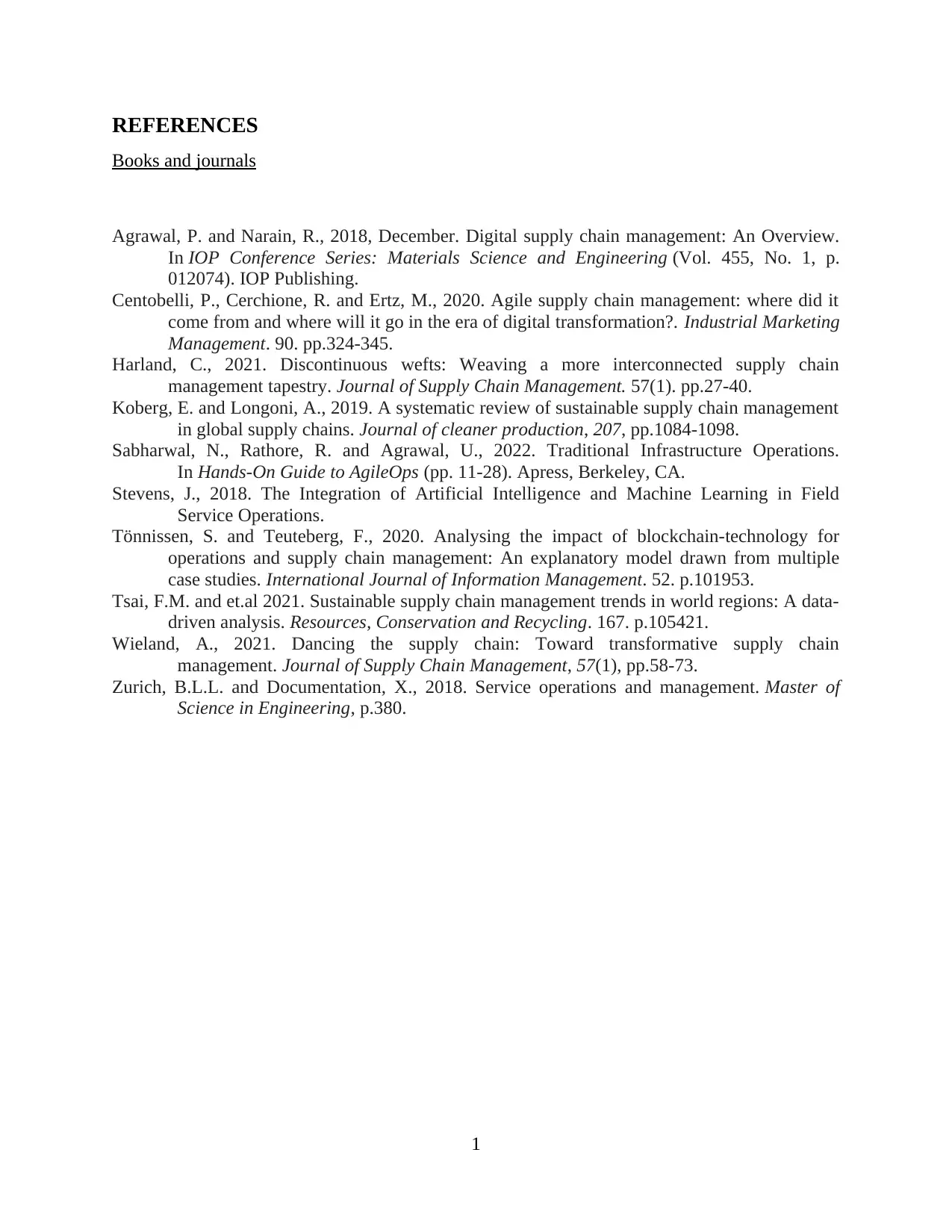
REFERENCES
Books and journals
Agrawal, P. and Narain, R., 2018, December. Digital supply chain management: An Overview.
In IOP Conference Series: Materials Science and Engineering (Vol. 455, No. 1, p.
012074). IOP Publishing.
Centobelli, P., Cerchione, R. and Ertz, M., 2020. Agile supply chain management: where did it
come from and where will it go in the era of digital transformation?. Industrial Marketing
Management. 90. pp.324-345.
Harland, C., 2021. Discontinuous wefts: Weaving a more interconnected supply chain
management tapestry. Journal of Supply Chain Management. 57(1). pp.27-40.
Koberg, E. and Longoni, A., 2019. A systematic review of sustainable supply chain management
in global supply chains. Journal of cleaner production, 207, pp.1084-1098.
Sabharwal, N., Rathore, R. and Agrawal, U., 2022. Traditional Infrastructure Operations.
In Hands-On Guide to AgileOps (pp. 11-28). Apress, Berkeley, CA.
Stevens, J., 2018. The Integration of Artificial Intelligence and Machine Learning in Field
Service Operations.
Tönnissen, S. and Teuteberg, F., 2020. Analysing the impact of blockchain-technology for
operations and supply chain management: An explanatory model drawn from multiple
case studies. International Journal of Information Management. 52. p.101953.
Tsai, F.M. and et.al 2021. Sustainable supply chain management trends in world regions: A data-
driven analysis. Resources, Conservation and Recycling. 167. p.105421.
Wieland, A., 2021. Dancing the supply chain: Toward transformative supply chain
management. Journal of Supply Chain Management, 57(1), pp.58-73.
Zurich, B.L.L. and Documentation, X., 2018. Service operations and management. Master of
Science in Engineering, p.380.
1
Books and journals
Agrawal, P. and Narain, R., 2018, December. Digital supply chain management: An Overview.
In IOP Conference Series: Materials Science and Engineering (Vol. 455, No. 1, p.
012074). IOP Publishing.
Centobelli, P., Cerchione, R. and Ertz, M., 2020. Agile supply chain management: where did it
come from and where will it go in the era of digital transformation?. Industrial Marketing
Management. 90. pp.324-345.
Harland, C., 2021. Discontinuous wefts: Weaving a more interconnected supply chain
management tapestry. Journal of Supply Chain Management. 57(1). pp.27-40.
Koberg, E. and Longoni, A., 2019. A systematic review of sustainable supply chain management
in global supply chains. Journal of cleaner production, 207, pp.1084-1098.
Sabharwal, N., Rathore, R. and Agrawal, U., 2022. Traditional Infrastructure Operations.
In Hands-On Guide to AgileOps (pp. 11-28). Apress, Berkeley, CA.
Stevens, J., 2018. The Integration of Artificial Intelligence and Machine Learning in Field
Service Operations.
Tönnissen, S. and Teuteberg, F., 2020. Analysing the impact of blockchain-technology for
operations and supply chain management: An explanatory model drawn from multiple
case studies. International Journal of Information Management. 52. p.101953.
Tsai, F.M. and et.al 2021. Sustainable supply chain management trends in world regions: A data-
driven analysis. Resources, Conservation and Recycling. 167. p.105421.
Wieland, A., 2021. Dancing the supply chain: Toward transformative supply chain
management. Journal of Supply Chain Management, 57(1), pp.58-73.
Zurich, B.L.L. and Documentation, X., 2018. Service operations and management. Master of
Science in Engineering, p.380.
1

2
⊘ This is a preview!⊘
Do you want full access?
Subscribe today to unlock all pages.

Trusted by 1+ million students worldwide
1 out of 12
Related Documents
Your All-in-One AI-Powered Toolkit for Academic Success.
+13062052269
info@desklib.com
Available 24*7 on WhatsApp / Email
![[object Object]](/_next/static/media/star-bottom.7253800d.svg)
Unlock your academic potential
Copyright © 2020–2025 A2Z Services. All Rights Reserved. Developed and managed by ZUCOL.





